Automatons
I wished to start with a definition of automatons but I couldn’t find one that satisfies me. In either case, what usually are understood as them are self-operating, moving, non-electronic devices that resemble humans, animals or other animate beings. They can be but not necessarily are capable of some useful functions.
I like to think of them as of precursors of robots, or at least as precursors of some robots. Indeed, back then when there were no electronics, fancy controllers, or a plethora of programming environments people still wanted to create something… alive. Or at least something that creates such an impression.
Today, when we have electronics and all these technologies we call them robots or at least ‘robotic’. Before the term ‘robot’ was invented there were automatons (or automata) and before that… well, there certainly was something.
Either real or mythical but automated, ‘artificially alive’ devices have been with us since the antiquity. I won’t go into much detail about this as I’ve already done it in my ‘Ancient robots’ article. You can read it if you haven’t done that already.
Next important time in history from this point of view is 8th to 13th century A.D., particularly – the Islamic world. I have an article on this topic too. Not that Europe was in some kind of ‘dark times’ it’s just the amount of sources we have. What’s known for sure is, that there were people in Medieval Europe who tampered with automatons. Villard de Honnecourt is one notable example.
At the time or Renaissance (15th – 17th centuries) there was an increased interest in the works of antique cultures. Many widely known scientists and engineers lived during this time. Among other fields some of them were interested in automated devices too.
One of the most renown scientists of this time is of course – Leonardo da Vinci. Still, he wasn’t the only one. There were others who have purportedly created automatons too. Some of these stories are feasible and verifiable, while some are quite implausible.
For example – it is said that Gianello della Tour of Cremona created several automatons. One of them – a walking lute player. Also, Salomon de Caus created a singing bird automaton. There are other stories like these, that seem quite plausible. On the other hand, there are some stories that seem like fiction to me.
In either case, I won’t go much into detail on these. The purpose of this article is to tell you something about some of the most advanced automatons that have made a serious impact on the way people understand technology and what it’s capable of.
Age of enlightenment and the 19th century
Age of enlightenment in Europe is a timespan from the middle of 17th century until the start of 19th century. Together with the 19th century Age of enlightenment was a period of time when the most advanced automatons were created.
Because of numerous reasons later they started to ‘die out’, and because of numerous reasons automatons before this time were nowhere near the sophistication level of these 18th – 19th century automated devices.
Jacques de Vaucanson
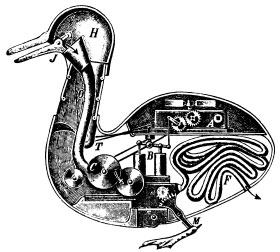
Jacques Vaucanson (1709 – 1782) was a French inventor and a really important man in robotics history. He’d probably be pretty surprised to find out his importance. The main topic of this article is automatons, he created some of the most advanced automatons of his time.
Apart from that, it was Vaucanson’s design that was later perfected by Jacquard in order to create the Jacquard’s loom. Furthermore, it was Vaucanson who envisioned how punch cards (in his case – a perforated paper roll) could be used to store a control sequence of a device – in other words a program.
There were three famous automatons created by Jacques de Vaucanson. None of them have managed to survive. Yet the information we have about these devices is quite astonishing. It seems that one of his goals was to demonstrate how things happened in nature and it seems that he was pretty good at it.
The transverse flute player was a wooden figure that could play twelve tunes using a transverse flute. The fascination of this device lies in a fact that it could, in fact, play a flute. Vaucanson managed to create a breathing system. So, the automaton breathed and played the flute for real.
A year later (1738) he added two more automatons to his exhibition – The galoubet and tambourine player and The Digesting duck. Not much is known about the first automaton apart from the fact that it could play 20 different tunes using a galoubet (that’s a type of flute) and a tambourine, you can get the idea if you watch this video:
It’s a real man in that video in case you wondered! As you can see the automaton should have been pretty capable and sophisticated if it was able to play something similar.
The last but not least of known Vaucanson’s automatons is The Digesting duck. It is said that the digesting duck could precisely imitate the mechanics of digesting, including swallowing, digesting itself and expel of waste material.
There’s a little controversy about whether the device really digested. Roubert-Houdin who examined the device said that the digestion was actually an illusion as the waste material was prepared earlier. Still, Alfred Chapuis in his book “The world of the automatons” states a different view.
He states that it could be that Roubert-Houdin actually examined a copy of this automaton, not the real device. Because the Houdin’s description doesn’t live up to Vaucanson’s description of the device. In either case this is one of the most important automatons in robotics history.
Friedrich von Knauss
Friedrich von Knauss (1724-1789) was a German watchmaker who among other creations created automatons too. I don’t know much about his creations. It is said that he created such devices that could write, play musical instruments and four mechanical heads that could speak.
His writer is the only one that has survived till now. As far as I’m aware it can be seen at Gewerbe museum, Vienna. Not like some later devices, this writer can write fairly long texts as its mechanism is stored outside his body.
Jaquet-Droz
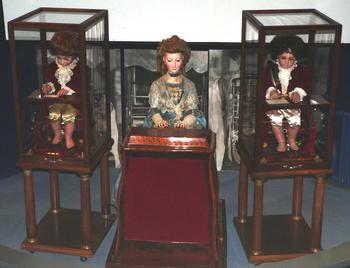
Pierre Jaquet-Droz (1721–1790) and his son Henri-Lois (1752-1791) were Swiss watchmakers. Both were well-educated in mathematics and physics, and both were exceptional engineers. Henri-Lois was a gifted musician too.
Already in 1738 Pierre Jaquet-Droz set up a wathmaker’s workshop. His horological creations were of exceptional quality and eventually he opened a second workshop in London and a watchmaking factory in Geneva. The Jaquet Droz brand is still alive. You won’t be able to get these watches at Amazon though.
Among watches they created humanoid and bird automatons. Mechanical birds and watches were the primary merchandise, while highly sophisticated humanoids were created as a showcase of technology and capabilities. In either case, these humanoids are their most famous automatons. Nowadays you can see them at the Musée d’Art et d’Histoire of Neuchatel, Switzerland.
So, there were three devices – The Draughtsman, The Musician and The Writer. The Draughtsman depicts a child, it can draw four different images. The Musician depicts a young lady that can play a specifically created musical instrument that works like an organ.
The writer can write a custom text up to 40 letters long using a quill. In this sense it’s a programmable device with a read-only memory. It should be noted that apart from their functions they do other things too to make them look as natural as possible.
The Silver Swan
The silver swan is a beautiful musical bird automaton that was created somewhere around 1773. It is said that its mechanisms were designed by John Joseph Merlin (1735-1803) and it was first owned by certain John Cox. However, it’s pretty clear that many masters put their hand to create it.
As its name suggests the machine made from silver depicts a swimming swan. The swan “swims”, looks in different directions and then catch a fish. The water effect is created by ingenious use of glass tubes, and the swan is moved using a clockwork mechanism.
Nowadays it can be seen in the Bowes museum, England. Every day at 2:00 pm it can be seen in action. The performance lasts 40 seconds. It can be understood from earlier descriptions that previously the mechanism itself and its performance were much more elaborate. You can see its performance in this video:
Maillardet brothers
Maillardet brothers – Jaques-Rodolphe, Henri, and Jean David created numerous automata in the beginning of the 19th century. It is said that they were apprentices of Jaquet-Droz and they worked together for some time.
Some of the most famous Maillardet automatons are their magicians and the writer-draughtsman. Two of their magicians – the little magician and the great magician can be seen in the International Museum of horology in Switzerland.
Both magician automatons can give answers to different questions. There are twelve question plates for the great magician. To initiate the sequence you have to put one of these plates in a special compartment and close it.
Then the magician will stand up, roll his eyes, and point his stick to an oval window where the correct answer appears. Other ‘special effects’ are presented too. The little magician works in a similar yet slightly different manner.
The writer-draughtsman, on the other hand, can be found in the Franklin institute, Philadelphia. This automaton can write three poems and draw four drawings. Initially it wasn’t known for sure who created this automaton, but when it was repaired it wrote it himself. You can see it in action in this video:
Steam men
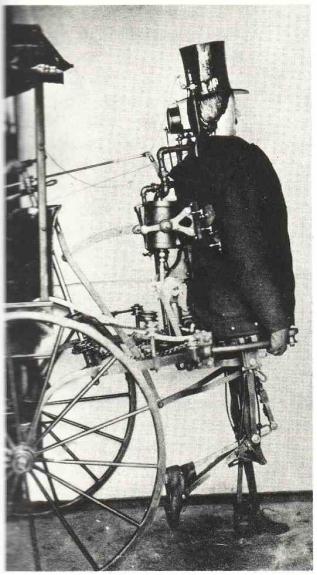
Yes, Steam MEN not MAN. There was more than one steam man. Although it’s not clear whether “purists” will regard them as automatons, I still think they’re worth mentioning. In my opinion, these walking steam machines is as full-blooded robot precursors as other machines mentioned in this article.
Some of the above mentioned automata could draw, some – write, some – play different musical instruments. All of these tasks are usually human specific. While walking and running aren’t exclusive to humans we often associate these tasks with ourselves.
There are two steam men I’m aware of. First one is Zadoc Dederick’s steam man created in 1868. Essentially it’s a mechanical man driven by a steam engine and connected to a cart in order to pull it around. The second is George Moore’s steam man created in 1893.
At that time sci-fi articles which featured steam men as means of transportation were popular, so sometimes everything regarding them is perceived as fiction. I’m not really sure about the second one, but you can examine Zadoc Dederick’s steam man’s patent if you have any doubts whether such device was designed at all.
Somehow I’m a bit happy that the idea didn’t quite catch on… I mean, can you imagine a situation where a good friend of yours comes at your place and starts to brag about his new BMW Gasoline Man – how fast it can run, how little it has to drink? Yeah, quite funny, isn’t it?
Chess automatons
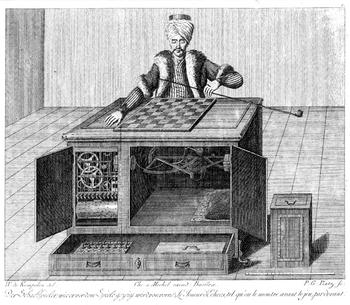
Engraving of The Turk
Mechanical devices that could compete with humans by playing chess. The level of artificial intelligence was so high that the machine could predict his opponents moves and plan ahead accordingly. And all this only by mechanical means…
Sounds too good to be true? Then it is! Come on, it’s just common sense. I mean, yeah there are programs that can beat humans in a chess game, at least they can beat me as I’m not a really good chess player, but it still requires amounts of calculation impossible to achieve at that time. Still, these devices created a lot of hype that time, and created good money-earning opportunities.
The first and probably the most famous is The Turk. The Turk was created in 1770 by Wolfgang von Kempelen, a Hungarian inventor. The device depicts a man dressed in oriental clothes who sits behind a cabinet with a chessboard on top of it. All mechanisms (and the human operator) were situated in this cabinet.
The Turk was exhibited in Europe and Americas for more than 80 years and he won most of his games. However, already around 1820 it was explained as a hoax. Still, it was an expressive spectacle and because of this success other similar pseudo-automatons were created.
One of these other pseudo-automatons was Ajeeb, a similar chess-playing machine operated by a human operator. It was created by Charles Hooper and first presented in 1868. It is said that many strong chess players have operated it and many prominent persons have played with Ajeeb.
Other chess machines include Mephisto and El Ajedrecista. Mephisto was created in 1876 by Charles Godfrey Gumpel and it had no hidden operator. It was a hoax but it was remotely controlled by other means. It is said that it was mainly controlled by Isidor Gunsberg.
El Ajedricista, on the other hand, is only device of the above mentioned that wasn’t a hoax. It’s a real chess playing machine that can automatically play (and win) an endgame in which the machine controls a king and a rook versus a human controlled king. It was created in 1912 by Leonardo Torres y Quevedo. El Ajedrecista and its improved version can be seen at the ‘Colegio de Ingenieros de Caminos y Puertos’ in Madrid, Spain.
Talking automatons
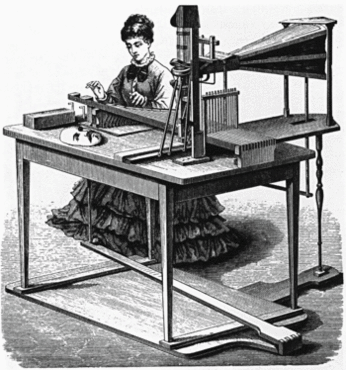
Today if we want to create a robot that can say some words we can create it pretty easily. All we have to do is ensure that the hardware can play audio files and then record some samples for different situations. Of course, such a robot won’t be capable of voice recognition, but it is possible to add this skill too. Appropriate software is all that’s needed.
But what do they did when there were no such possibilities? It turns out that talking machines aren’t present-specific things. There were people who strove to create machines that could talk or imitate the human voice.
In 1780 Abbot Mical at Imperial Academy of Sciences’ annual competition In St Petersburg presented his creation – two heads that could carry out a short conversation. Also, the device had a keyboard that an operator could use to construct other words and sentences.
The other two devices weren’t actually automatons as they explicitly required a human operator in order to “speak”. Still, I’ll mention them here in case you wonder. First one is a speaking machine made by Wolfgang von Kempelen – the same man who created the Turk.
Unlike the Turk, Kempelen’s speaking machine wasn’t a fraud. He devoted more than 30 years to develop his machine before he exhibited it in 1804. In its last iteration it could speak complete phrases in French, Italian, English and German if the operator was skillful enough.
Joseph Faber’s “Euphonia” or “The Marvelous talking machine” was another machine that could speak. An operator could control it using foot pedals and keys similar to those of a piano. It was imagined that this machine could be connected to a telegraph that could then read out loud the received text. This never happened and the device was seen more like an amusement.
The dulcimer player
The dulcimer player is an automaton created by watchmaker Pierre Kintzing and cabinet maker David Roentgen in 1772 in Germany. In 1785 it was bought by Marie-Antoinette and later given to the Academy of Sciences. Now it can be seen at the Museum of Technology in Paris.
Basically, it’s an 18 inches tall humanoid android depicting a young woman who plays dulcimer. It/She can play 8 different tunes. We have to thank Roubert-Houdin as it wouldn’t be possible to see it today if he wouldn’t have repaired it in 1864 after the device was heavily damaged during the French revolution. You can see it in operation in this video:
Jean Eugene Robert-Houdin
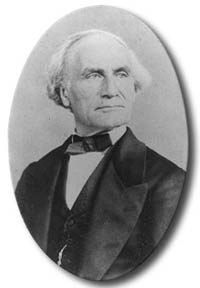
Possibly you’ve heard about this man from another perspective. He is often viewed as the founding father of modern conjuring. He invented many new illusions and improved old ones. Also, he has served as an inspiration to other great magicians.
The thing is – his father was a watchmaker and wanted him to be a lawyer, yet young Jean wanted to be a watchmaker instead. A story tells that it was an accident that he acquired some illusionist books, he was buying books on watchmaking instead.
In either case, he got pretty interested in conjuring. And here comes the mix – as he was a watchmaker he new how to create devices that could help him in his illusions – automatons. Jean Eugene Robert-Houdin created many automated devices to help him.
Some where purely autonomous, some – human operated. It’s hard to draw the line, the man was a conjurer after all! Nonetheless, no one dares to question the geniality of his creations.
The time from 1850 till 1910 is often regarded as the golden age of automatons. At that time there were many artisans who earned their living creating clockwork mechanism driven automated devices. Often they were not as complicated as some earlier devices. Yet the sheer size of this industry at that time makes it the golden age.
So what happened later? The war of course. After the war people started to mass-produce things. So automatons transformed to simpler mechanical toys, singing birds and music boxes. The motivation to spend years to hand-craft device-specific parts to build large, complicated automatons also perished.
Nevertheless, automatons are surely ancestors of robots. The fact that people bothered to create such devices to demonstrate technology or to make the world a better place shows us why people today create robots.
In this article I talked mainly about automatons created in the western world. But what happens if you merge together eastern philosophy and world view with influences of western technology? Karakuri ningyo is a Japanese automatic doll tradition. I’ll write an article on it shortly!
